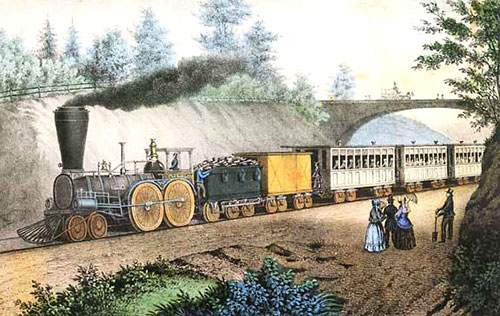
Image courtesy of Wikimedia Commons.
Throughout the 1800s, May 1 was Moving Day in American cities, the day when old leases ran out and new ones began. Overloaded carts jammed narrow streets in New York, Boston and other cities as families made their way to new lodgings. An observer in the 1830s described the chaotic scene as “[r]ich furniture and ragged furniture, carts, wagons, and drays, ropes, canvas, and straw, packers, porters, and draymen...occupy the streets from east to west, from north to south, on this day.”
The writer and abolitionist Lydia Maria Child considered Moving Day an “emblem of this country, and this age...stand on the side-walks of New-York, and watch the universal transit on the first of May.” For Child and other Americans, this annual event reflected the general restlessness of a restless 19th-century population on the move, as the children and grandchildren of the Revolutionary generation flowed into new territories and formed new settlements. New Englanders seemed especially prone to travel far from their birthplaces as they succumbed to what one observer described as “Yankee roam-all-over-the-world-itiveness.”
A growing network of roads, canals, and railroads connected new and old in a transportation revolution that would shape the future of the new nation. Before the war for independence, travel options were limited, costly and slow. People could sail along the coastline and on interior waterways, take a stage or other horse-drawn vehicle over unimproved, rutted lanes, or simply travel by “shank’s pony,” that is, to walk from place to place. After the war, Americans sought opportunities to cut both the time and high cost of travel; a Senate Committee determined that it cost as much to transport a ton of goods overland in the new nation as it did to ship it from Europe. New technologies and improvements spurred efforts to spread existing and create new transportation networks that facilitated the movement of people and goods. One observer noted approvingly that turnpikes could stimulate settlement even in what had previously been "a trackless forest." Inspired by England's impressive canal projects, Americans saw a bright future for building their own canals and, later, railroads.
Political disagreements quickly erupted, however, as Whigs championed federal funding for "internal improvements" such as turnpikes and canals while Democratic Republicans warned of costly projects and excessive federal spending. In consequence, the transportation revolution took place at the state and local level. States harnessed private capital by chartering corporations to erect bridges, improve roads and construct canals. The citizens of New York constructed the 362-mile Erie Canal at a cost of $7,000,000. Drawn by tow ropes pulled by horses on a tow path that ran parallel to the canal, boats traveled at four miles an hour. A welcome change from the bone-jarring experience of riding the stagecoach, canal fares were as low as two cents per mile. One traveler declared that being able "to sit on the deck of a boat and see the country slide by you, without the slightest jar" was one of life's "exquisite luxuries." More important than the delights of canal travel to canal investors and users were the profits the canal promised. Goods traveled far more quickly and more cheaply than they could in wagons lumbering overland. Over 3,000 miles of canals were in use across the nation by 1840 and cities sprang up in the interior of the country as part of a market revolution linking the eastern seaboard to the western interior.
When the U.S. Supreme Court ruled in 1824 against a monopoly on steamship traffic in Gibbons vs. Ogden, the door to open competition on the nation's water and roadways swung wide. It is no coincidence that Cornelius "Commodore" Vanderbilt founded one of the greatest family fortunes in American history by shrewdly and boldly capitalizing on the transportation revolution. Fortunes were made and lost as stockholders invested in railroad, steamboat, turnpike and canal ventures. Many more lost money than succeeded, but the real winner was the American public, as competition for freight and passengers fueled rate wars and drove fares down.
Canals were a costly engineering challenge and not always navigable in winter. They were quickly surpassed by a new and speedier transportation innovation: the railroad. By 1835, travelers could “ride the cars” from Worcester to Boston and the line extended to Springfield, Massachusetts, four years later. As early as 1839, Henry David Thoreau noted that the Middlesex Canal, which ran from Lowell to Boston, Massachusetts, exhibited "almost an antique look beside the more modern-railroads" materializing beside it. During the 1840s the United States surpassed every other country in the world in the number of miles of railroad tracks. By 1850 it had tripled to over 9,000 miles.
Innovations in ocean transportation did not lag behind railroads. The first oceangoing steampowered vessel sailed across the Atlantic in 1838. By 1840, the Cunard Line pioneered regular passenger and freight steamship service between Liverpool and Boston. Steamships dramatically reduced transatlantic travel time, which traditionally took several weeks by sailing ship. In 1850, it took only a couple of weeks for the Edward and Orra Hitchcock to travel by steamship from Boston to Liverpool, England. Once they arrived, they noted that rail travel at home was as comfortable as riding the cars in England. As opportunities for cheaper, speedier travel proliferated, middle class as well as wealthy tourists became part of a seasonal transportation scene as they sought out natural wonders like Niagara Falls in New York, geological features like New Hampshire’s Old Man of the Mountain, or, in the case of the Hitchcocks, European destinations.